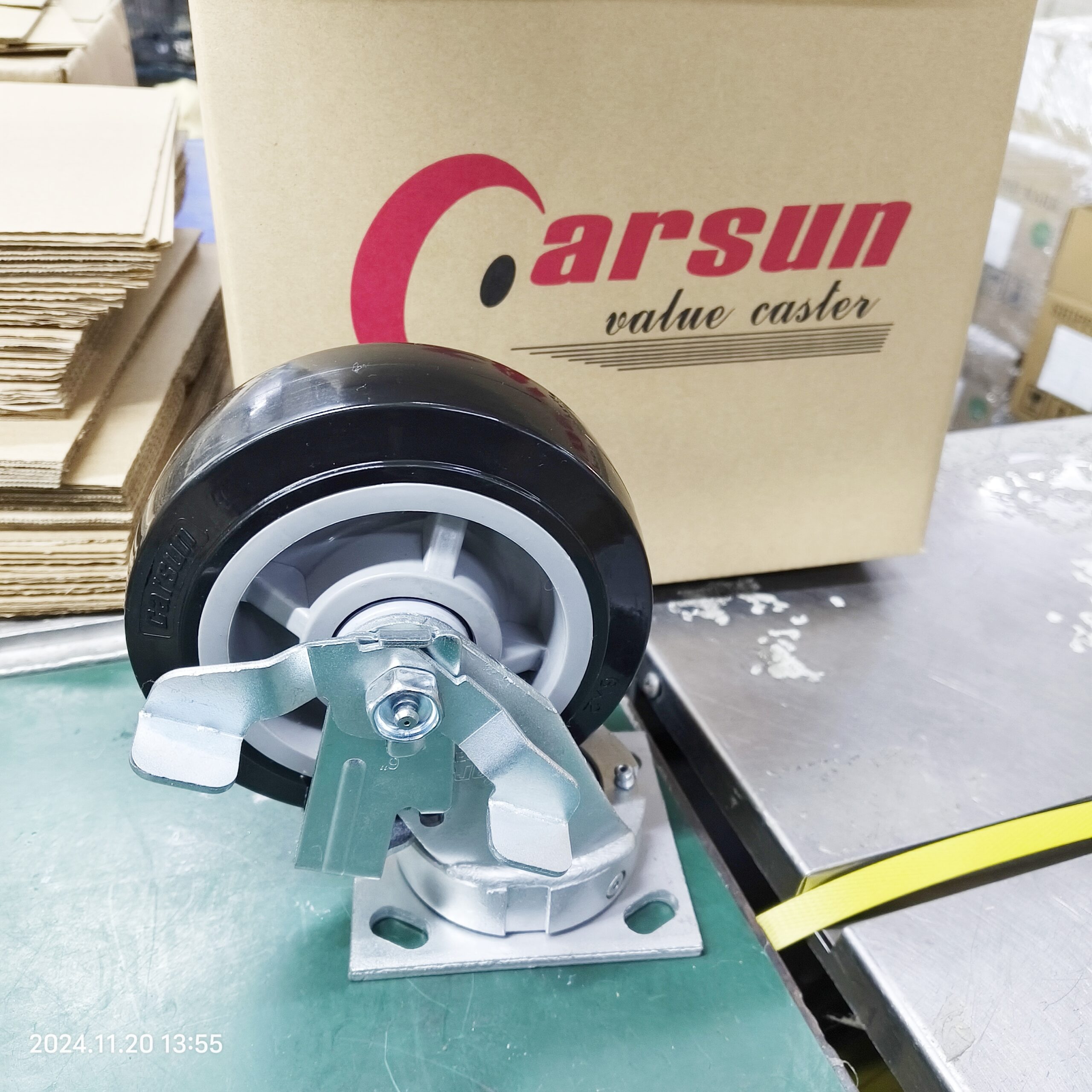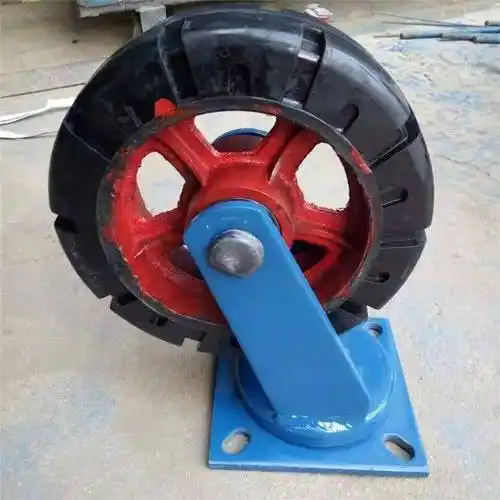How New Tech Makes Industrial Caster and Wheel Awesome
Industrial Caster and Wheel are the unsung heroes in factories, warehouses, and all kinds of industrial places. They might seem like simple parts, but they play a really important role in helping to move heavy equipment, machinery, and materials. In fact, without them, many industrial operations would have a hard time running smoothly. However, the world of industrial casters and wheels isn’t staying the same. Because of new and ongoing technological improvements, these important components are changing in amazing ways, getting better in performance, lasting longer, and having more functions.
Industrial Trolley Wheel and Caster
The Basics of Industrial Caster and Wheel
Before we look at the new technologies, it’s important to really understand what Industrial Caster and Wheel are and what they do.
What are Industrial Casters?
An industrial caster is a wheeled thing that gets attached to the bottom of something like a cart, a machine, or a piece of equipment. This makes it easy to move that object around. Casters usually have a wheel, a mounting bracket (also called a yoke), and a bearing system. The mounting bracket connects the caster to the object, and the bearing system makes the wheel turn smoothly.
There are two main kinds of industrial casters: fixed casters and swivel casters. Fixed casters can only roll in a straight line. Swivel casters, on the other hand, can turn all the way around (360 degrees). This makes it a lot easier to move things in small, tight spaces or to change directions. Some casters also have brakes. You can use these brakes to lock the caster in place and stop the object from moving.
Swivel Industrial Caster and Fixed Wheel
Types of Industrial Wheels
Industrial wheels come in all sorts of shapes, sizes, and materials. Each one is made to meet different needs. Some of the most common types of industrial wheels are:
Rubber Wheels: These are popular because they can absorb shocks really well. That makes them great for use on uneven surfaces. Rubber wheels also have good traction, which helps stop them from slipping.
Nylon Wheels: Nylon wheels are known for being tough and not wearing out easily. They’re often used when you need a wheel that can carry a lot of weight.
Polyurethane Wheels: As we talked about before, polyurethane wheels are becoming more and more popular. They can absorb shocks well, carry heavy loads, and are resistant to chemicals and rubbing.
Steel Wheels: Steel wheels are really strong and tough. They’re perfect for jobs that need a lot of strength. But they can be noisy, and if you’re not careful, they can damage floors.
Cast Iron Wheels: Cast iron wheels are also very strong and can handle heavy loads. They’re often used in industrial places where you need a high level of toughness.
Material Innovations
One of the biggest ways that new technologies are changing Industrial Caster and Wheel is through material innovations.
High – Strength Alloys for Caster Frames
In the past, caster frames were often made from traditional metals like steel or iron. While these materials are strong, they have some limitations. New high – strength alloys are now being used to make caster frames. These alloys are a mix of different metals and sometimes other elements. They offer a lot of advantages. For example, they can be stronger than regular steel but also lighter in weight. This makes the casters easier to move around, especially when they’re carrying heavy loads. Also, these alloys are often more resistant to corrosion. In industrial environments where there might be moisture, chemicals, or other things that can cause rust and damage, this corrosion resistance is really important. It means the caster frames will last longer, and you won’t have to replace them as often. This saves both time and money for businesses.
Advanced Polymer Composites for Wheels
Polymer composites are another area where there have been big changes. Scientists and engineers are creating new and improved polymer materials for industrial wheels. These advanced polymers can be designed to have specific properties. For instance, some are made to be even more resistant to wear and tear. In industrial settings, wheels can go through a lot of friction and rubbing, especially when they’re used frequently. Wheels made from these new polymers can handle this better and stay in good shape for a longer time.
Some polymer composites are also designed to be more flexible. This flexibility can be really helpful when the wheels are rolling over uneven surfaces. The flexible wheels can adapt to the bumps and dips, which makes the ride smoother. It also helps to protect the equipment that’s being moved on the wheels. If the ride is too bumpy, it can cause damage to the equipment.
Industrial Runner and Rolling Element
Design Improvements
New technologies are also leading to some great design improvements in industrial casters and wheels.
Ergonomic Caster Designs
Ergonomics is all about making things easier and more comfortable for people to use. In the case of industrial casters, ergonomic designs are becoming more common. For example, some casters are designed to have a lower resistance when you start to move them. This means that workers don’t have to use as much force to get a heavy cart or piece of equipment moving. It reduces the amount of physical effort needed, which is better for the workers’ bodies, especially if they have to move heavy things all day long.
Some casters also have better – designed handles or grips on the mounting brackets. This makes it easier for workers to hold onto the caster when they’re moving the object. It gives them more control and can prevent accidents.
Modular Caster Systems
Modular caster systems are another interesting design innovation. These systems are made up of different parts that can be easily put together or taken apart. This has a lot of benefits. For one thing, it makes it easier to customize the caster to fit specific needs. If you need a caster with a certain type of wheel or a particular mounting bracket, you can just pick the parts you want and assemble them.
It also makes maintenance a lot simpler. If one part of the caster breaks, you don’t have to replace the whole thing. You can just swap out the broken part. This saves time and money. And when it comes to storage, modular caster systems are more convenient. You can store the parts separately, which takes up less space.
Smart Technology Integration
The integration of smart technology is one of the most exciting developments in the world of industrial casters and wheels.
Sensor – Equipped Casters
Many industrial casters now come with sensors. These sensors can do all sorts of things. For example, they can measure the weight that the caster is carrying. This is really useful because it can prevent overloading. If a caster is carrying too much weight, it can break or cause problems with the equipment it’s attached to. The sensor can send a signal to a control panel or even to a worker’s mobile device if the weight limit is being exceeded.
Sensors can also monitor the temperature of the caster. High temperatures can be a sign of problems, like too much friction or a bearing that’s starting to fail. By keeping an eye on the temperature, workers can catch these issues early and fix them before they turn into bigger problems.
Another thing sensors can do is track the movement of the caster. They can tell how fast it’s moving, how far it’s traveled, and even the direction it’s going. This information can be used to optimize the movement of equipment in a factory or warehouse. For example, if a caster is moving too slowly in a certain area, it might be a sign that there’s a problem with the floor or the equipment.
Connectivity and Data Analytics
Some smart casters are connected to a network. This means they can send and receive data. The data from these casters can be analyzed to learn a lot of things. For example, by looking at the data on how often a caster is used, businesses can figure out which parts of their operations are the busiest. They can then use this information to plan better, like making sure they have enough equipment in those busy areas.
Data analytics can also help with predicting maintenance needs. By looking at the data from the sensors over time, companies can see patterns. If a caster starts to show signs of wear and tear earlier than expected, they can schedule maintenance before it breaks down. This helps to keep the industrial operations running smoothly and reduces unexpected downtime.
Future Prospects
The future of industrial casters and wheels looks really promising, with even more new technologies on the horizon.
Nanotechnology Applications
Nanotechnology is a field that deals with really tiny things, at the nanometer scale. In the future, we might see nanotechnology being used in the production of industrial casters and wheels. For example, nanomaterials could be added to the materials used for caster frames and wheels to make them even stronger and more durable. These nanomaterials could fill in the tiny gaps and flaws in the regular materials, making them more resistant to damage.
Nanotechnology could also be used to create self – cleaning surfaces on casters. In industrial environments, casters can get dirty really quickly, and this dirt can affect their performance. Self – cleaning surfaces would make it easier to keep the casters clean, which would help them work better and last longer.
3D Printing for Customization
3D printing is already being used in many industries, and it’s likely to have a big impact on the production of industrial casters and wheels in the future. With 3D printing, it will be possible to create highly customized casters and wheels. If a business has a very specific need, like a caster with a unique shape or a wheel with a special pattern, they could just design it on a computer and then use a 3D printer to make it.
This would save a lot of time and money compared to traditional manufacturing methods. Instead of having to create expensive molds or go through a long production process, the 3D printer can make the part right away. It would also allow for more experimentation and innovation in the design of industrial casters and wheels.
In conclusion, new technologies are changing industrial casters and wheels in many ways. From better materials to smart sensors and exciting future prospects, these advancements are making these components more efficient, durable, and useful. As technology continues to develop, we can expect even more amazing changes in the world of industrial casters and wheels.








